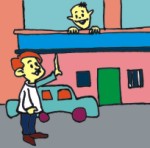| Learner's Club
You like to read, don't you?
Earlier we discussed about how in our everyday conversation we constantly use questions and answers, for example,
: Did you see Nira?
: No, I didn't.
Or,
: Have you read 'Anna Karenina'?
: Yes, I have.
: When did you read it?
: When I was in high school. |
 |
 |
Or,
: Are you new here?
: No, not really.
: Oh, how long have you been here?
: For about eight months. |
Notice that the questions can roughly be divided into two types: the yes/no questions and the wh-questions. The yes/no questions usually have the rising intonation (i.e. in asking the question the voice of the speaker usually rises at the end of the sentence), whereas, the wh-questions have a falling intonation (i.e. the voice of the speaker falls at the end of the question).
However, there is a different kind of question which is very common in English. This is known as the 'Tag question'. A tag-question is in fact a question in the form of a statement + a question tag. Tag questions are often used in conversational English. Read the following mini dialogues.
 |
A. : You can type, can't you?
: Yes, I learnt it during the summer holiday.
B : It isn't raining, is it?
: No, I don't think so. |
C. : The colour is nice, isn't it?
: Oh, yes. It's very attractive.
D : You are coming with us, aren't you?
: Yes, I'll be joining you in a minute.
|
 |
Notice that generally in tag questions, when the statement is positive, the tag is negative; and when the statement is negative the tag is positive. For example:
The colour is nice, isn't it?
or, It isn't raining, is it?
We usually use tag questions when we want the other person to agree with what we are saying. Tag questions encourage or invite the other person to have the same opinion as the speaker.
For example, when I ask someone “Is the colour nice?” I am expecting either a yes or no answer.
But when I ask the same person “The colour is nice, isn't it?”, I am indirectly encouraging the person to say “Yes, it is.”
Note that the use of proper intonation (i.e. the up and down of the voice. You should already be familiar with this) is important here.
There are two intonations that may be used:
i) Voice rises at the end. This means you are asking for information.
Even though you expect to hear 'yes', you are not really sure.
ii) Voice drops at the end. You are pretty sure of yourself; however, you are politely asking for the other's agreement.
Read the following dialogue to see more use of question tags.
A. Sohel : Neena, you went to see 'Hamlet' last night, didn't you?
Neena : Oh, yes. I did. But how do you know? Did you come to my house last evening?
Sohel : No, I didn't. Anyway, you couldn't hear the dialogues very well from \
where you sat, could you?
Neena : No, I couldn't. But wait, how did you know? You were there, weren't you?
Sohel : Yes, dear. I was sitting just two rows behind you.
Neena : But why didn't you come up and talk to me after the play was over?
Sohel : You were with Shamim. You wouldn't have liked that,
would you? |
|
B. Alam : It's cold today, isn't it?
Hafiz : Well, remember it's November.
Alam : But last November wasn't cold, was it?
Hafiz : Not in the first week. But it got cooler later, didn't it? |
 |
 |
C. Doctor : Good morning, Mr. Ali. What has brought you in today?
Patient : 'Morning, Doctor. My blood sugar has gone up again.
I've been feeling very weak and dizzy for the last few days.
Doctor : You've been eating sweets again, haven't you?
Patient : Only a bit, Doctor.
Doctor : And you are not walking regularly, are you?
Patient : Well, I don't really get any time.
Doctor : You've been overworking again, haven't you?
Patient : I couldn't avoid it, Doctor.
Doctor : But you know how important it is for you to walk regularly, don't you?
|
All the tags so far have been positive-negative or negative-positive. For instance:
You sent them your resignation letter yesterday, didn't you?
You didn't send them your resignation letter yesterday, did you?
But although negative-negative never occurs, we do sometimes use positive-positive tags:
: Guess who called me this morning!
: It was Shanto, was it?
: Well....
: So, he's still calling you, is he?
: Yes, but not from Dhaka. He's in Singapore now.
: So, he's got a job over there, has he?
|
 |
Remember that positive-positive tags always have rising intonation. This kind of tag shows great interest and sometimes a little irony.
Here's today's exercise for you. First add a question tag to each of the statements
in D. Then match a response from E with a tag question in D.
D. i) You are not resigning from your job, ___________?
ii) Shyamal worked as a salesman for a while, __________?
iii) He isn't the only cardiologist in town, _________?
iv) You agree with my views about good education, _______?
v) You can use a computer, ____________? |
 |
E. i) Well actually he is.
ii) Yes, I did a course last year.
iii) What else can I do? I've no other option.
iv) Yes, just before he got his present job in the bank.
v) Well, to some extent, yes.
|
Note: Be careful not to confuse question tags with actual short questions. For example:
: I really enjoyed the food. Did you?
: Yes, very much. I've never eaten anything like this before. Have you?
: I think Nina once made something like this, but that was a long time ago.
: Well, I'll have coffee now. Will you?
As you see, there is a change of subject in the question; the subject has become /and you:
: I enjoyed the food. Did you?
: I'll have coffee. Will you?
Copyright
(R) thedailystar.net 2006 |
|
